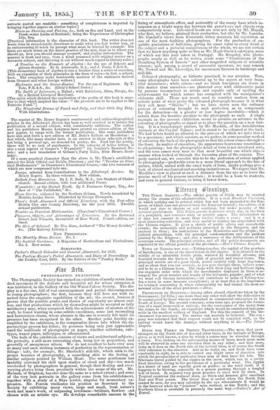hut
PHOTOGRAPHIC EXHIBITION.
The Photographic Society has opened an exhibition of nearly seven hun- dred specimens of the delicate and beautiful art for whose extension it was instituted, in the Gallery of the Old Water-Colour Society. The dis- play is a fine one, full of real encouragement and partial discouragement to young photographers; the first, because they will here see with re- newed force the exquisite capabilities of the art ; the second, because it proves that the possible grades and shades of superiority are almost end- less, and that productions which by themselves might be accepted as fully satisfactory may, when compared with the achievements of.masters of the craft, be found wanting in some subtile excellence, some last reconciling and harmonious charm, whose absence in the one is scarcely felt until its presence has been recognized in the other. another point forcibly ex- emplified by the exhibition, is the comparative disuse into which the da- guerreotype process has fallen ; its presence being only just appreciable amid the multitude of photographs on paper, whether collodions, cab- types, waxed paper, talbotypes, or albumenized. The bulk of the exhibition consists of views and architectural subjects ; the portraits, a still more interesting class, being few in proportion, and generally of anonymous sitters. We do not recollect to have ever seen so many and such striking instances of perfection in the representation of foliage : take, for example, Mr. Sherlock's still-life, which adds to the proper beauties of photography, a something akin to the feeling of similar subjects painted by William Hunt. The same gentleman has laudably exercised his skill upon studies of cloud and sky—too much overlooked by photographers in general, though their fleeting and ever- varying glories bring them peculiarly within the scope of the art. Mr. Hannah, of Brighton, has also done the same to a minor extent ; and some of the very best portraits in the gallery come from his establishment, together with a study of a Skye terrier, singular for momentary ex- pression. Mr. Fenton vindicates his position as Secretary to the Society by exhibiting many views, large and small, from nature's work and man's work, of surpassing loveliness—brilliant, flawless. and chosen with an artistic eye. He develops remarkable success in the fixing of atmospheric effect, and noticeably of the sunny haze which in- terposes on a bright warm day between the gazer's eye and objects even comparatively near. Life-sized heads are sent not only by Mr. Maya]],
• who first, we believe, attained their production, but also by Mr. Laroche. Mr. Cundall's views from Fountains Abbey maintain his reputation as ono of the most faultless photographers. For the production of ex- quisite gradations of half-tone, giving its exact value to every detail of the subject and a pictorial completeness to the whole, we are not certain that we know anything quite so fine as Mr. Hugh Owen's calotypes, some of which are this year taken in Portugal. Mr. Kingsley, who photo- graphs nearly as well as he writes, sends some "Illustrations of the Breathing System of Insects" and other magnified subjects of scientific interest ; and, among a crowd of successful operators, we may remark Mr. Nowell and Mr. Llewellyn, for uncommon fineness in landscape and still-life.
Coloured photography, as hitherto practised, is our aversion. True, some photographs have been coloured up to the aspect of very beau- tiful miniatures ; while others—and we think foreigners sin worse in this matter than ourselves—are plastered over with obliterative paint by persons incompetent as artists and capable only of spoiling the achievements for which nature has conspired with the manipulator's elaborate skill. Those not much used to consider matters from an artistic point of view prefer the coloured photograph because it is what they call more "lifelike " ; but we have never seen the ordinary process of colouring brought to such perfection as to compensate for the detraction—in a greater or less degree inevitable—which it entails from the beauties peculiar to the photograph as such. A single example in the present exhibition seems to promise an advance in the colouring of photographs, so signal as to place the question on a new foot- ing. It is a waxed-paper picture, by Mr. Macklin, of the Antediluvian Animals at the Crystal Palace; and is stated to be coloured at the back. We had before heard an allusion to the process of which we infer this to be a specimen; and which consists, as we gather, in some peculiar method of colouring the back of the photograph so that the colour comes through to the front. As matter of execution, the appearance bears some resemblance to oil-painting ; but the photographic detail of form is not interfered with, and the tone comes very near to that most beautiful one which objects assume when looked at through the focussing glass of the camera. Pro- perly carried out, we conceive this to be the perfection of colour applied to photography—preferable even to a more literal approach to the hue of nature, which, united with the exact truth of form, might perhaps give a look of almost mechanical and mocking imitativeness. We regret that Mr. Macklin's view is placed at such a distance from the eye as to leave the precise merit of his process uncertain ; it would be a boon to students, and even to general visitors, to bring it lower down.






























 Previous page
Previous page